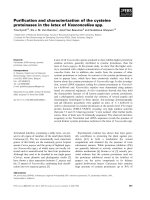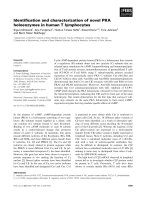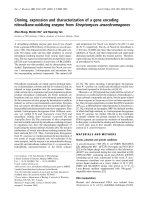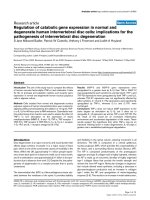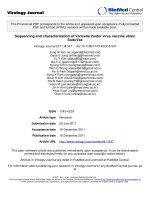Sequencing and characterization of hox gene clusters in japanese lamprey (lethenteron japonicum)
Bạn đang xem bản rút gọn của tài liệu. Xem và tải ngay bản đầy đủ của tài liệu tại đây (3.49 MB, 168 trang )
SEQUENCING AND CHARACTERIZATION OF HOX
GENE CLUSTERS IN JAPANESE LAMPREY
(LETHENTERON JAPONICUM)
TARANG KUMAR MEHTA
BSc. Biomedical Science (Honours)
Nottingham Trent University, 2004
MRes. Molecular and Cellular Biology
Nottingham Trent University, 2007
A THESIS SUBMITTED FOR THE DEGREE OF DOCTOR OF
PHILOSOPHY
INSTITUTE OF MOLECULAR AND CELL BIOLOGY
&
DEPARTMENT OF PAEDIATRICS,
YONG LOO LIN SCHOOL OF MEDICINE
NATIONAL UNIVERSITY OF SINGAPORE
2013
DECLARATION
I hereby declare that this thesis is my original work and it has been written by
me in its entirety. I have duly acknowledged all the sources of information
which have been used in the thesis.
This thesis has also not been submitted for any degree in any university
previously.
………………………………………
Tarang Kumar Mehta
23
rd
August 2013 (Revised 14
th
February 2014)
i
Acknowledgements
There are several people I would like to acknowledge:
First and foremost I would like to thank my supervisor, Professor Byrappa
Venkatesh for his patience, superb mentorship, and the amount of time he
devoted into improving my scientific writing and presentation skills;
I would also like to thank my thesis-advisory committee (TAC) members, Dr
Paul Robson, Dr Samuel Chong, and Dr Sydney Brenner for their guidance and
suggestions throughout the course of my PhD;
Dr Alice Tay for her advice on presentations and at conferences. Additionally, I
would also like to thank the DNA Sequencing Facility, Chew Ah-Keng and
other lab members, who were excellent in handling and processing my samples
both efficiently and effectively;
Dr Ravi Vydianathan for his all-round mentoring throughout my PhD and work
towards my first manuscript. He showed me the ropes in all scientific
disciplines and without which, I would not have been able to progress as a
scientist;
Tay Boon-Hui for her constant guidance and support in scientific techniques,
and her immaculate lab-managing skills allowing for a safe lab working
environment;
Sumanty Tohari for maintaining a healthy balance between social and work life
activities and making the lab an all round enjoyable place to not only grow as a
scientist, but as a person too;
Dr Alison Lee for her valuable comments and work on the manuscript, and
with Michelle Lian, the both of them have done a fantastic job in assembling
the Japanese lamprey genome and have helped me with various aspects of
ii
bioinformatics. In the same breath I must also thank the collaborative effort
between Dr. Sydney Brenner’s lab at Okinawa Institute of Science and
Technology (OIST, Japan), and our lab in IMCB, for generating the
sequencing data for the Japanese lamprey genome;
Lim Zhi-Wei for teaching me zebrafish transgenics and being an all-round
approachable individual in the lab;
The Zebrafish facility for doing an excellent job in maintaining my fish
according to all standard animal regulations;
All present and former members of the Comparative and Medical Genomics
Laboratory and DNA Sequencing Facility in IMCB, Singapore for making the
laboratory a pleasant and beneficial place to work and grow as a scientist;
The staff of A*Star, Singapore International Graduate Award (SINGA) and
Yong Loo Lin School of Medicine, NUS for handing me this fantastic
opportunity to work in a great environment, among great scientists. I would
also like to thank them both the efficient handling of administrative affairs;
All of the interesting and diverse group of friends that I have made here in
Singapore who have made my experiences both here and in South-East Asia
both exciting and enjoyable;
Finally, I would like to thank my late father and mother, and my sister who
without their efforts and support, I would not have progressed so far in life.
iii
Table of contents
Acknowledgements i
List of tables vii
List of figures viii
List of abbreviations x
Chapter 1: Introduction 1
1.1 Hox proteins 1
1.2 Hox gene clusters 2
1.3 Function of Hox proteins in metazoans 6
1.3.1 Cnidaria 6
1.3.2 Protostomes 7
1.3.3 Deuterostomes – Ambulacraria 8
1.3.4 Deuterostomes – Vertebrates 8
1.4 Expression and regulation of Hox genes 11
1.5 Cis-regulatory elements 19
1.5.1 Methods to predict cis-regulatory elements 20
1.5.2 Comparative genomics approach to predict cis-regulatory elements
24
1.5.3 Testing the function of predicted cis-regulatory elements 24
1.6 Genome duplication in the stem vertebrate lineage 27
1.7 Jawless vertebrates (cyclostomes) 29
1.8 Hox genes in jawless vertebrates (cyclostomes) 32
1.9 Objectives of my work 35
Chapter 2: Materials and methods 38
2.1 Japanese lamprey BAC libraries 38
2.2 Screening of BAC libraries 38
2.3 Screening potential positive clones 39
2.4 Sequencing ends of BAC inserts 40
2.5 Shotgun-sequencing of BAC clones 40
2.5.1 Large scale isolation of plasmid DNA 41
2.5.2 Sequencing plasmid DNA 41
2.6 Assembling BAC shotgun reads 42
iv
2.7 Japanese lamprey whole genome sequence 43
2.8 Annotation and analysis of genes 43
2.9 Predicting conserved noncoding elements (CNEs) 45
2.10 Functional assay of CNEs in transgenic zebrafish 46
Chapter 3: Results – Hox clusters in the Japanese lamprey 49
3.1 Screening of lamprey BAC libraries 49
3.2 Sequencing and assembly of BAC clones 50
3.3 Mining the Japanese lamprey genome assembly for Hox genes 53
3.4 Determining orthology of lamprey Hox gene clusters 62
3.4.1 Phylogenetic analysis 62
3.4.2 Analysis of gene synteny 71
3.5 Sizes of Japanese lamprey Hox clusters 73
3.6 Absence of Hox12 gene in lamprey 78
3.7 microRNA in Japanese lamprey Hox clusters 79
Chapter 4: Results – Conserved noncoding elements (CNEs) in the Hox gene
clusters 82
4.1 Introduction 82
4.2 CNEs in lamprey and representative gnathostome Hox loci 82
4.3 Functional assay of CNEs 97
4.3.1 Functional assay of αCNE2 98
4.3.2 Functional assay of αCNE5 101
4.3.3 Functional assay of βCNE2 and βCNE3 103
4.3.4 Summary of expression patterns driven by selected lamprey
CNEs 105
Chapter 5: Results – Genome duplications in the lamprey lineage 107
5.1 Japanese lamprey Hox clusters and their duplication 107
5.2 Comparative analysis of non-Hox genes in lamprey and
representative gnathostomes 108
5.3 Lamprey and gnathostome genome duplication history 110
Chapter 6: Discussion 117
Bibliography 128
Appendix 141
List of publications 155
v
Summary
Cyclostomes (comprising lampreys and hagfishes) are the sister group of
living jawed vertebrates (gnathostomes) and are therefore an important group
for understanding the origin and diversity of vertebrates. In vertebrates and
other metazoans, Hox genes determine positional identities along the
developing embryo and are implicated in driving morphological diversity.
Invertebrates typically contain a single Hox cluster (intact or fragmented)
whereas elephant shark, coelacanth and tetrapods contain four Hox clusters
owing to two rounds (‘1R’ and ‘2R’) of whole-genome duplication during
early vertebrate evolution. By contrast, most teleost fishes contain up to eight
Hox clusters due to an additional genome duplication event (‘3R’) in the ray-
finned fish lineage. In my project, using a combination of sequences from
BAC clones and a draft genome assembly, I provide evidence for at least six
Hox clusters in the Japanese lamprey (Lethenteron japonicum). Unlike the
compact gnathostome Hox clusters, lamprey Hox clusters are large and highly
repetitive and are therefore organized more like the single invertebrate Hox
cluster. Cis-regulatory elements conserved in lamprey and gnathostomes
represent elements that were present in the common ancestor of all vertebrates.
Such elements must be playing a fundamental role in the regulation of
vertebrate Hox cluster genes and can be identified as conserved noncoding
elements (CNEs) by comparing lamprey and gnathostome Hox clusters. By
aligning the lamprey Hox clusters with the four Hox clusters of elephant shark
and human, I identified 13 CNEs. Transgenic zebrafish assays indicated the
potential of selected lamprey and human/mouse CNEs to function as
vi
enhancers (cis-regulatory elements), driving reporter gene expression
resembling the expression pattern of certain Hox genes in the cluster.
The presence of more than four lamprey Hox clusters suggests that its lineage
has experienced an additional round of genome duplication compared to
tetrapods. Further support for this is provided by the presence of additional
non-Hox gene/gene family paralogs in the Japanese lamprey genome
compared to the human genome. If my inference of an additional round of
genome duplication in the lamprey lineage is correct, previous inferences
stating that the lamprey lineage has experienced only 1R and 2R need to be
reexamined. Because of the GC-bias of the lamprey genome, which affects
codon usage patterns and amino acid composition, phylogenetic analysis was
not informative for timing the 1R and 2R events relative to lamprey and
gnathostome divergence. Alternatively, I sought clues about the timings of 1R
and 2R by analyzing the Hox clusters of lamprey and gnathostomes. First, the
synteny of genes linked to each lamprey Hox cluster is different to those
linked to gnathostome Hox clusters. Secondly, individual lamprey Hox
clusters share CNEs across four paralogous elephant shark and human Hox
clusters suggesting a many-to-many orthology relationship between lamprey
and gnathostome Hox clusters. These independent lines of evidence suggest
that the lamprey and gnathostome lineages may not have shared the first two
rounds (1R and 2R) of genome duplication, implying independent genome
duplication histories for the two lineages followed by an additional whole-
genome duplication event in the lamprey lineage.
vii
List of tables
Table 1 – Repeat element content (%) in the four complete Hox clusters of the
Japanese lamprey. 76
Table 2 - Conserved noncoding elements (CNEs) between the Japanese
lamprey Hox-α, -β, -γ, and -δ clusters and the four Hox clusters (HoxA, B, C
and D) of elephant shark (C. milii) and human. 85
Table 3 – CNEs selected for functional assay in transgenic zebrafish. 97
viii
List of figures
Figure 1 – Hox gene clusters in chordates. 5
Figure 2 – Mouse (Mus musculus) Hox gene clusters (A) and their collinear
expression along the embryonic anterior-posterior axis (B). 14
Figure 3 – Hox genes previously identified in jawless vertebrates. 33
Figure 4 – Tol2 transgenesis in zebrafish. 48
Figure 5 – Schematic diagram of Hox contigs derived from sequencing 32
BAC clones. 52
Figure 6 - Japanese lamprey Hox gene loci obtained from the combined data
set of 32 BAC clones and draft genome assembly. 55
Figure 7 - Hox clusters in the Japanese lamprey. 59
Figure 8 – The unique exon-intron structure of Japanese lamprey Hox- η4 and
Hox-θ4. 60
Figure 9 – Alignment of protein sequences of Japanese lamprey Hox-δ4, Hox-
η4, and Hox–θ4 genes. 61
Figure 10 – Phylogenetic analyses of Japanese lamprey Hox4 genes using
second exon coding (nucleotide) sequences and protein sequences. 65
Figure 11 – Phylogenetic analyses of Japanese lamprey Hox13 genes using
only the second exon sequence. 66
Figure 12 – Phylogenetic analyses of Japanese lamprey Hox9 genes using full-
length coding (nucleotide) sequences and protein sequences. 67
Figure 13 – Phylogenetic analyses of Japanese lamprey Hox11 genes using
full-length coding (nucleotide) sequences and protein sequences. 68
Figure 14 – Phylogenetic analyses of Japanese lamprey Hox8 genes using full-
length coding (nucleotide) sequences and protein sequences. 69
Figure 15 – Comparison of Japanese lamprey, human, elephant shark and
coelacanth Hox loci. 72
Figure 16 – Comparison of four Hox clusters (HOXA, B, C, and D) in human
and anole lizard with the lamprey Hox clusters (Hox-α, -β, -γ, and –δ) and the
single amphioxus Hox cluster. 75
Figure 17 – Average content of repetitive elements in Hox clusters of various
chordates. 78
Figure 18 - VISTA plot of the MLAGAN alignment of Japanese lamprey Hox-
α cluster with the four Hox clusters (A to D) of elephant shark and human. 86
Figure 19 – Alignment of partial exon1 and intron of mouse, zebrafish, and
elephant shark HoxB4 and lamprey Hox-α4 genes. 87
Figure 20 - VISTA plot of the MLAGAN alignment of Japanese lamprey Hox-
β loci with the four Hox clusters (A to D) of elephant shark and human. 89
Figure 21 – Alignment of part of the human Hs246_enhancer element and
orthologous CNE regions from elephant shark (Callorhinchus milii), zebrafish
(Danio rerio), and the Japanese lamprey. 91
ix
Figure 22 - VISTA plot of the MLAGAN alignment of Japanese lamprey Hox-
γ cluster with the four Hox clusters (A to D) of elephant shark and human. 92
Figure 23 - VISTA plot of the MLAGAN alignment of Japanese lamprey Hox-
δ cluster with the four Hox clusters (HoxA to D) of elephant shark and human.
93
Figure 24 - CNEs shared between each of the four lamprey Hox clusters and
human Hox clusters 95
Figure 25 - 3D graph of the number of CNEs shared between human, elephant
shark (C. milii), and fugu Hox clusters. 96
Figure 26 – Expression pattern driven by lamprey αCNE2 and its human
homolog in 3 dpf F1 generation zebrafish embryos. 99
Figure 27 – Expression pattern driven by lamprey αCNE5 and its mouse
homolog in 3 dpf F1 generation zebrafish embryos. 101
Figure 28 – Expression pattern driven by lamprey Hox-βCNE2 and Hox-
βCNE3 and its human homolog in 3 dpf F1 generation zebrafish embryos. . 104
Figure 29 – Three models for WGD histories in lamprey and gnathostome
lineages and their expected phylogenetic topologies. 111
Figure 30 - Schematic diagram of Japanese lamprey Hox clusters and a single
flanking gene (if available). 116
Figure 31 - Graphical representation of spatial (left of the cluster) and
temporal (right of the cluster) expression patterns of the Japanese lamprey
Hox-α, -β, and –ε cluster genes in Japanese lamprey embryos. 121
x
List of abbreviations
1R first round of whole genome duplication
2R second round of whole genome duplication
3R third round of whole genome duplication
BAC bacterial artificial chromosome
BI Bayesian Inference
bp base-pair
CNE conserved noncoding element
CNS central nervous system
DNA deoxyribonucleic acid
DNase deoxyribonuclease
ELCR early limb control region
EtBr ethidium bromide
Gb gigabase
GCR global control region
GFP green fluorescent protein
kb kilobase
lincRNA large intergenic noncoding RNA
LINE long interspersed nuclear element
lncRNA long noncoding RNA
LTR long terminal repeat
Ma million years ago
Mb megabase
McFos mouse cFos basal promoter
xi
miRNA microRNA
ML Maximum-Likelihood
ncRNA noncoding RNA
NJ Neighbor-Joining
nt nucleotide
PCR polymerase chain reaction
PG paralogous group
PTU 1-phenyl 2-thiourea
RNA ribonucleic acid
RT-PCR reverse transcription polymerase chain reaction
SINE short interspersed nuclear element
TAE Tris-acetate-EDTA
TF transcription factor
TFBS transcription factor binding site
TSGD teleost-specific genome duplication
TSS transcription start site
UTR untranslated region
WGD whole genome duplication
YFP yellow fluorescent protein
1
Chapter 1: Introduction
1.1 Hox proteins
Hox proteins are transcription factors that play a crucial role in developmental
patterning by establishing positional identities along the anterior-posterior
embryonic axis in most metazoans (see section 1.3). Hox proteins are also
responsible for patterning the embryonic axis of metazoans that lack an
anterior-posterior axis and are not bilaterally symmetrical, like Cnidaria (Ryan
et al. 2007). Furthermore, Hox protein are also crucial for patterning certain
structures independent of an anterior-posterior axis, like those of cephalopods
(Lee P. N. et al. 2003) and tetrapod limbs. Along with defining external
morphological features, Hox proteins also control the accurate development of
the nervous system and internal organs, as well as the vertebrate axial skeleton
(see section 1.3).
Hox proteins are characterized by the presence of a highly conserved 60 amino
acid, helix-turn-helix motif known as the homeodomain. The triple helical
nature of the homeodomain allows for DNA binding at each helix for
regulation of gene transcription. Upstream of the homeodomain, Hox proteins
have a pentameric region binding the three amino acid loop extension (TALE)
proteins at the N-terminus, and downstream, an acidic tail at the C-terminus.
The binding of Hox cofactors such as Exd in Drosophila and Meis or Pbx in
mammals to a motif N-terminal to the homeodomain, increases the stability of
Hox protein binding to DNA. Hox proteins function as activators as well as
repressors of downstream genes by specifically binding to DNA sequences in
2
their target’s regulatory regions, known as Hox-response enhancers.
Information about the function of Hox proteins has been largely obtained
through the study of Hox mutations. Mutations in Hox proteins can induce
dramatic phenotypic changes such as homeotic transformations, whereby
segment identities are morphologically altered and one body part develops into
another. One classical example is the Antennapedia (Antp) mutant of the fruit
fly (Drosophila melanogaster) (Schneuwly et al. 1987). This is a dominant
gain-of-function mutant where ectopic expression of Antp in a head segment
causes legs to develop in place of antenna on the fly’s head. Mutations of
human Hox proteins also lead to severe phenotypes; nonsense and missense
mutations in HoxA13 (Mortlock and Innis 1997; Goodman et al. 2000) and
HoxD13 (Muragaki et al. 1996; Johnson et al. 2003) cause genetic disorders of
limb formation such as hand–foot–genital syndrome (HFGS), synpolydactyly
(SPD), and brachydactyly. Because of the crucial role of Hox proteins in
patterning the embryonic axis and internal organs of diverse organisms, it is
important to characterize Hox genes and proteins in different metazoan
lineages, which would enable a better understanding of their contributions to
the morphological diversity of metazoans.
1.2 Hox gene clusters
In all metazoans, Hox genes are either arranged in intact or broken clusters on
chromosomes in the genome. Invertebrates typically have a single Hox cluster.
While the single Hox cluster is intact in some invertebrates, it is split into two
or more fragments in some or totally atomized in others resulting in singleton
Hox genes dispersed across the genome. Protostomes are the earliest branching
3
clade of Bilateria. They can be subdivided into two major groups,
Lophotrochozoa which include the widely studied annelid, Caenorhabditis
elegans (roundworm), and Ecdysozoa which include the well studied
arthropod, Drosophila (fruit fly). In C. elegans there is an atomized Hox cluster
consisting of six Hox genes that include one anterior Hox gene, ceh-13, two
linked middle-group paralogs, lin-39 and mab-5, and three linked posterior
paralogs egl-5, nob-1, and php-3 (Burglin and Ruvkun 1993). In the traditional
genetic model, the fruit fly, the Hox cluster is split into two complexes, known
as the antennapedia and bithorax complexes (Lewis 1978; Kaufman et al.
1980). Among chordates, amphioxus (Branchiostoma floridae) representing the
cephalochordates and the most basally branching clade, possesses a single
intact Hox cluster with 15 Hox genes (Fig. 1) (Amemiya et al. 2008; Holland et
al. 2008). In stark contrast, the single Hox cluster in urochordates, the sister
group of vertebrates (Delsuc et al. 2006) is highly disintegrated. For example,
the ascidian Ciona intestinalis has a highly disintegrated cluster of nine Hox
genes with several rearrangements (Seo et al. 2004) whereas the larvacean
Oikopleura dioica has a completely atomized Hox cluster with only two
duplicated Hox9 genes remaining linked (Fig. 1) (Ikuta et al. 2004). In contrast
to invertebrates, all examined vertebrate taxa to date possess variable numbers
of multiple Hox clusters. The numbers of Hox clusters in vertebrates generally
reflect the evolutionary history of genome duplications in the respective
lineages. All tetrapods possess four Hox clusters (HoxA, HoxB, HoxC, and
HoxD) (Fig. 1) (Krumlauf 1994) which have been attributed to two rounds of
whole-genome duplication (WGD) events known as 1R and 2R during the
early evolution of vertebrates (Dehal and Boore 2005; Putnam et al. 2008).
4
Likewise, the elephant shark (Callorhinchus milii), a Holocephalan
cartilaginous fish (Ravi et al. 2009) and the two coelacanth species, Latimeria
menadoensis and Latimeria chalumnae (Amemiya et al. 2010; Higasa et al.
2012) also possess four Hox clusters (Fig. 1). An exception here are the
Elasmobranch cartilaginous fishes such as the little skate (Leucoraja erinacea)
and small-spotted catshark (Scyliorhinus canicula) which have only three Hox
clusters each (Fig. 1), with the HoxC cluster being completely lost presumably
due to a genomic deletion after the divergence of holocephalan and
elasmobranch lineages (King et al. 2011). There is now incontrovertible
evidence that the ancestor of teleost fishes experienced an additional round of
genome duplication (“teleost-specific genome duplication” or TSGD) after it
diverged from the tetrapod ancestor (Fig. 1) (Christoffels et al. 2004; Jaillon et
al. 2004). This has resulted in teleost fishes possessing almost twice the number
of Hox clusters as tetrapods. Basally branching teleost lineages such as
Elopomorpha (e.g., European eel, Anguilla anguilla) and Hiodontiformes (e.g.,
goldeye, Hiodon alosoides) have retained all eight clusters (HoxAa, -Ab, -Ba, -
Bb, -Ca, -Cb, -Da and -Db) (Chambers et al. 2009; Henkel et al. 2012). In
contrast, acanthopterygians such as fugu, medaka and stickleback have lost a
duplicate HoxC cluster (Málaga-Trillo and Meyer 2001) whereas cyprinids
such as the zebrafish have lost a duplicate HoxD cluster (Fig. 1) (Amores et al.
1998). Among teleosts, the salmonid lineage has undergone a more recent
tetraploidization event after the TSGD (Fig. 1)(Allendorf and Thorgaard 1984).
Thus it is no surprise that 13 Hox clusters were identified in the Atlantic
salmon (Salmo salar) (Fig. 1) (Mungpakdee et al. 2008).
5
Figure 1 – Hox gene clusters in chordates.
Stars indicate whole genome duplication events. Figure modified from (Ravi et
al. 2009)
In contrast to the detailed information available for Hox genes and clusters in
jawed vertebrates (gnathostomes such as cartilaginous fishes, lobe-finned
fishes, tetrapods and teleosts), the organization of Hox clusters is yet to be
definitively elucidated in jawless vertebrates (cyclostomes such as lampreys
6
and hagfishes). A draft genome assembly of the sea lamprey (Petromyzon
marinus) was recently generated based on DNA isolated from the liver (Smith
et al. 2013). Detailed analysis of this assembly provided evidence for two Hox
clusters and an additional eight Hox genes that could not be assigned to any
cluster. Nevertheless, the identification of four Hox genes from paralogous
group (PG) 9 in the sea lamprey genome suggests that its genome contains at
least four Hox clusters (Smith et al. 2013).
1.3 Function of Hox proteins in metazoans
1.3.1 Cnidaria
Cnidaria, the sister group to Bilateria are the only non-bilaterian phyla with
identifiable Hox proteins (Larroux et al. 2007). Compared to the twin body axis
of Bilateria, Cnidaria have a single body axis referred to as the oral-aboral axis
(Technau and Steele 2011). They exhibit various stages of life cycle
comprising a larval (planula) stage followed by a pelagic (polyp) or a benthic
(medusa) form (Technau and Steele 2011). Contrary to certain arguments
against the presence of true Hox proteins in Cnidaria (Kamm et al. 2006), the
majority of studies support that a group of Hox proteins are involved in
patterning the oral-aboral axis of Cnidaria (Gauchat et al. 2000; Masuda-
Nakagawa et al. 2000; Yanze et al. 2001; Finnerty et al. 2004; Ryan et al.
2007). The evolutionary history of Hox function in Cnidaria is made complex
as a result secondary gene losses, variable expression patterns along the oral-
aboral axis and at different stages of development among different cnidarian
taxa (Chiori et al. 2009). For example, the Hox9-14 group A gene from the
hydrozoan Clytia hemisphaerica is expressed at the oral pole of the planula
7
whereas its ortholog in another hydrozoan, Eleutheria dichotoma is expressed
only at the medusa stage (Kamm et al. 2006). In addition, certain orthologs are
expressed at the same stage but located at opposite poles along the oral-aboral
axis. For example the Hox9-14 group B gene of the hydrozoan Podocoryne
carnea is expressed at the oral pole (Yanze et al. 2001) whereas its ortholog in
the anthozoan, Nematostella vectensis displays expression at the aboral pole
(Finnerty et al. 2004; Ryan et al. 2007).
1.3.2 Protostomes
Bilateria comprise two groups, protostomes and deuterostomes. Protostomes,
the earliest branching clade of Bilateria include two well-studied organisms
with a distinct anterior-posterior axis, namely Caenorhabditis elegans
(roundworm) and Drosophila (fruit fly). A number of famous studies in
Drosophila found that a series of recessive and dominant mutations could
induce homeotic transformations of the fly body plan. In a well-known
example, the loss-of-function Ultrabithorax (Ubx) mutant converts the
‘wingless’ third thoracic (T3) segment into a second thoracic (T2) segment
with wings, ultimately producing a mutant four-winged fly (Bender et al.
1983). In Drosophila (and most bilaterians), Hox proteins play critical roles in
patterning the embryonic central nervous system (CNS). For example, the Hox
gene products of labial (lab) and Deformed (Dfd) are important for
regionalizing neuronal identity in the Drosophila brain (Hirth et al. 1998).
Studies in C. elegans on the other hand found that of the six Hox genes in its
genome, only products of the anterior gene, ceh-13 and the two most posterior
Hox genes, nob-1 and php-3 are required for proper embryonic patterning as
8
triple loss-of-function mutants with defective lin-39, mab-5, and egl-5 genes
can still develop into fertile adults (Kenyon et al. 1997; Wrischnik and Kenyon
1997).
1.3.3 Deuterostomes – Ambulacraria
Within deuterostomes, ambulacrarians are the most basally branching clade
comprising Xenoturbellida, Hemichordata and Echinodermata.
Characterization of Hox genes and function in Xenoturbellida is incomplete
having identified only five partial Hox genes in Xenoturbella bocki (Fritzsch et
al. 2008). The echinoderm sea urchin, Stronglyocentrotus purpuratus has an
unusual penta-radial (and not bilateral) symmetric body-plan and its genome
contains a rearranged cluster of 11 Hox genes (Cameron et al. 2006). Five of
these Hox gene products are important for specifying the five points of the
penta-radial body plan during adult stages of embryonic development (Arenas-
Mena et al. 2000). As opposed to the peculiar penta-radial body plan of
echinoderms, their sister group, hemichordates are bilaterally symmetrical. In
the hemichordate, Saccoglossus kowalevskii, the complete complement of 12
Hox genes pattern the anterior-posterior axis (Aronowicz and Lowe 2006).
Modifications of the two-most posterior Hox genes (with reverse orientation) in
the hemichordate clusters are thought to have altered the function of their
protein product, driving posterior axial innovations such as tails, stalks, and
holdfasts (Freeman et al. 2012).
1.3.4 Deuterostomes – Vertebrates
9
Within deuterostomes, chordates are the sister group to ambulacrarians.
Vertebrates are the largest subphylum of chordates and morphologically
diverse. Numerous studies have looked into the evolution of Hox protein
function in controlling axial morphology and patterning various organs, tissues,
and cell types within this morphologically distinct group of organisms. Data on
Hox protein function in the earliest branching clade of extant vertebrates,
jawless vertebrates is non-existent however, certain studies have managed to
follow the expression pattern of some Hox genes in Japanese lamprey embryos
(Takio et al. 2004; Takio et al. 2007); see section 1.8. In jawed vertebrates on
the other hand, a number of studies have gained useful insights into Hox
function within major groups, namely tetrapods (studies in mice, chick, snakes,
and frogs) and teleost fishes (studies in zebrafish). Key information regarding
Hox protein function in vertebrates is predominantly derived from the
manipulation of Hox activity in chick embryos or gain/loss-of-function studies
in mice. The focus of this section will be related to the functions of each of the
39 Hox proteins in mice as they have been established by a series of targeted
mutations. Such mutations have demonstrated that the inactivation or
overexpression of certain Hox genes products result in the transformation of
anatomical regions. More specifically, mice lacking Hoxa1 exhibit defects in
hindbrain segmentation (Lufkin et al. 1991; Chisaka et al. 1992) whereas
Hoxa2/Hoxb2 compound mutants completely lack interrhombomeric
boundaries between rhombomere 1 (r1) and rhombomere 4 (r4) (Davenne et al.
1999). Such studies demonstrate that products of the earliest expressed Hox1
and Hox2 genes are important for the initial stages of hindbrain development
and compartmentalization. More posteriorally, the generation of Hox PG4 to
10
PG11 mutants display abnormal spinal cord development; this includes a
reduced and disorganized phrenic motor column region in the cervical-brachial
spinal cord junction of Hoxa5/Hoxc5 mutants (Philippidou et al. 2012),
degeneration of the second spinal ganglion in Hoxb8 mutants (van den Akker
et al. 1999; Holstege et al. 2008), and the loss of lumbar motor neurons in
Hoxc10 mutants (Hostikka et al. 2009). Additionally, Hoxb13 mutants display
a caudally extended spinal cord and defective sensory innervations of the tail
(Economides et al. 2003). Such studies highlight the critical role that Hox
proteins play in neuronal specification of the CNS. Meanwhile, other studies
have concentrated on the role of Hox proteins in axial skeleton development of
mice. For example, the loss of Hoxd3 induces the formation of defective first
and second cervical vertebrae (Condie and Capecchi 1993). On the other hand,
overexpression of HoxPG6 induces ectopic rib formation at the cervical and
lumbar regions, highlighting the importance of this paralog group for rib
morphogenesis (Vinagre et al. 2010). In contrast, the expression of Hox PG10
is able to inhibit rib formation as demonstrated by the complete absence of ribs
after the activation of Hoxa10 in the presomitic mesoderm (Wellik and
Capecchi 2003). The production of floating ribs (as opposed to those attached
to the sternum) is under the control of Hox PG9 as shown by a higher than
expected number of ribs attached to the sternum upon complete inactivation of
all members of Hox PG9 (McIntyre et al. 2007). Meanwhile, the loss of
Hoxd11 results in changes associated with sacral patterning (Davis and
Capecchi 1994). Such mutation studies of members from Hox PG3 to PG11
suggest that these genes are also vital for patterning the axial skeleton.
11
The function of vertebrate Hox proteins are not only limited to patterning the
primary body axis, CNS, and the axial mesoderm, but also involved in the
development of other systems independent of an anterior-posterior axis, like for
example the urogenital system (Taylor et al. 1997), vertebrate digestive system
(Sekimoto et al. 1998), paired appendages (Ruvinsky and Gibson-Brown 2000)
and heart looping (Soshnikova et al. 2013). For example, specific compound
deletion of the HoxA and HoxB clusters result in mouse embryos with
deficient heart looping (Soshnikova et al. 2013). Additionally, the inactivation
of both HoxA and HoxD clusters in mice induce a severe reduction in limb
size, highlighting the combined role of both HoxA and HoxD cluster genes in
limb development (Kmita et al. 2005). Such studies are all the more interesting
when comparisons are made with the function of Hox genes in fellow tetrapods
with an atypical body plan, like for example the snake. The elongated body
plan of snakes is characterized by a loss of limbs, an increased number of
vertebrae, and reduced skeletal regionalization along the primary body axis.
Such striking morphological differences are thought to have occurred by
sequence changes in particular snake Hox genes that altered their expected
axial boundaries and certain body regions compared to other tetrapods e.g. the
significantly extended thorax (Woltering et al. 2009; Di-Poi et al. 2010). Such
variations in vertebrate morphology between taxa are fascinating and in part,
derived from a diversification of mechanisms regulating Hox gene expression
and protein function during embryonic development.
1.4 Expression and regulation of Hox genes
12
The presence of Hox genes in all studied metazoans and their specific
expression patterns along the embryonic axis indicate a conserved role for this
feature. An interesting aspect that emerged from the genetic analysis of
Drosophila Hox genes was the idea of ‘spatial collinearity’ whereby the
ordered arrangement of Hox genes in a cluster affects body patterning from the
anterior to the posterior of the organism (Lewis 1978). Most invertebrate Hox
genes are expressed in an anterior to posterior manner according to their
ordered arrangement within the cluster (spatial collinearity). In C. elegans, the
majority of Hox genes display a spatial collinear order of expression along the
anterior-posterior axis (Tihanyi et al. 2010). However, the anterior Hox gene,
ceh-13, extends it expression domain from anterior to posterior regions
(Tihanyi et al. 2010). Such breaks in collinearity may have facilitated the
evolutionary innovations of the ceh-13 gene which, unlike other C. elegans
Hox genes, is involved in multiple developmental roles including cell adhesion,
cell fusion, cell migration, growth rate, and fertility (Brunschwig et al. 1999;
Tihanyi et al. 2010). In the archetypal single Hox cluster of the
cephalochordate amphioxus, Branchiostoma lanceolatum, Hox1, Hox3, Hox4,
Hox7, and Hox10 genes all follow a spatial collinear order of expression along
the CNS and mesoderm (Pascual-Anaya et al. 2012). However, a break in
spatial collinearity was observed for both Hox6 which was expressed more
anteriorally than Hox4, and Hox14, which was expressed in both anterior
(cerebral vesicle) and posterior (mid-hindgut, posterior notochord, and tail bud)
structures (Pascual-Anaya et al. 2012). Other invertebrate Hox genes display a
limited order of spatial collinearity due to their atomized organization. Among
urochordates, the ascidian Ciona intestinalis display a limited collinear order of
